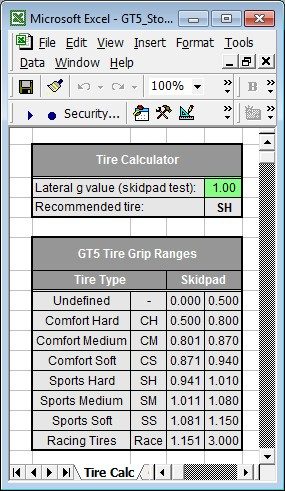After 3 more nights of testing and mumbling under my breath about PD's incredibly simplistic (so it seems) tire model, it finally dawned on me how effective it actually is, once you understand it and select the correct tires for each car. The problem isn't with the approach they took, but rather the implementation of it. Sound familiar?

The problem is due to the way GT5 randomly assigns tires to cars. My first guess was that PD just used SM for sports cars, CH on economy cars, etc. But even this isn't really accurate; there doesn't seem to be any rhyme or reason as to how they assigned default tires. And to take it a step further, every AI car in any given A-spec event is assigned the same tire type, whether it makes sense for each car or not. (This may be due to the AI using a completely different physics engine than the player cars, but who knows).
Using nothing but reported IRL skidpad numbers... if you fit the car with the recommended tire based on the chart I developed, it starts acting like an actual car. So far I've tested this approach on approximately 30 different cars, and in every case the car "drove" EXACTLY as I expected it to. Cars that shouldn't handle well don't; but not in a "oh crap I need racing softs" way. Rather, you can usually feel it when you are on the edge and it's pretty easy to learn where that point is. Going with the wrong tire in either direction makes a huge difference in how realistic the car feels, so it's pretty critical to match the tire to the car's real-life grip level as closely as possible.
I found myself on more than one occasion dialing in some traction control on a powerful car like I would IRL, rather than just running to the tune shop for a new suspension or softer tires. It also breathes new life into the braking model (although I'm still disappointed with it), and makes the cars' weight much more obvious. It has definitely taken the GT5 driving experience to a whole new level for me. I was literally laughing out loud last night while running laps in various cars fitted with their "real-life" tires; it was a blast!

So anyway, I created
a spreadsheet that will do the dirty work for you as long as you have a real-life skidpad number, but if you want to look up the tire yourself, here is a screenshot:
Just find where the car's IRL skidpad number falls between the last two columns, and use the tire type for that row. Anything between .8 and 1.15 will equate to one of the 6 non-race grip levels. Grip numbers above 1.15 equate to racing tires (usually selected based on wear IRL), and anything below .5 is non-realistic and is just used as a placeholder.
DISCLAIMER:
Before anyone starts... I know all about inconsistency in skidpad testing, the fact that we don't even have a skidpad in GT5, the fact that this doesn't account for acceleration/braking, game physics vs. real life, etc. etc. BUT... it just seems to work; I don't know exactly why, but it does.
My results are all based on "factory" cars with stock suspensions and settings. Modified suspensions and race cars will skew the results (but probably not as much as you would expect).
There are obviously going to be exceptions to the rule, but in most cases this would be a car whose skidpad number is on the border between two different tires, or one that has some weird type of suspension or something. I honestly can't think of one car that I've tested so far that was really out in left field, but I'm sure they exist.
The second sheet in the spreadsheet contains the list of cars that I have numbers for, along with their skidpad number and recommended tire (60 cars in all). You can add a car to the list and put in the g number, and it will automatically fill in the tire column. Skidpad numbers shown in yellow were taken from the same car but a different year or from a car with a different trim level, but they should be close. Also note that I didn't include the duplicated cars like all the Miata's and Skylines; that would easily double the car count.
For those of you using
my Matchmaker spreadsheet, tire data for each car will be incorporated within the next couple of releases.
As I mentioned in my last post, please feel free to pass along any skidpad numbers or sources for that information.


 .
.

 Similarly, there is a definite change in grip on and off line in the rain, so who knows.
Similarly, there is a definite change in grip on and off line in the rain, so who knows.


